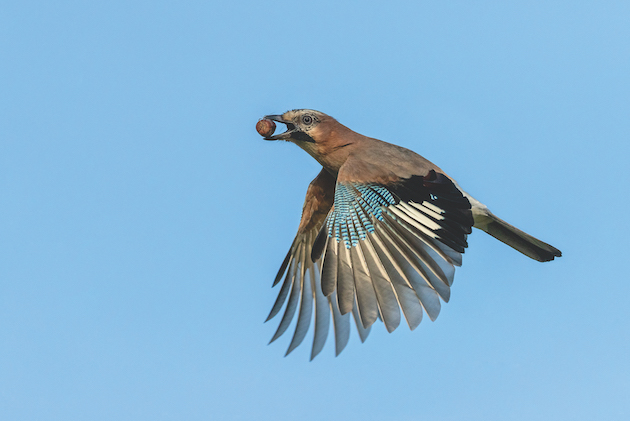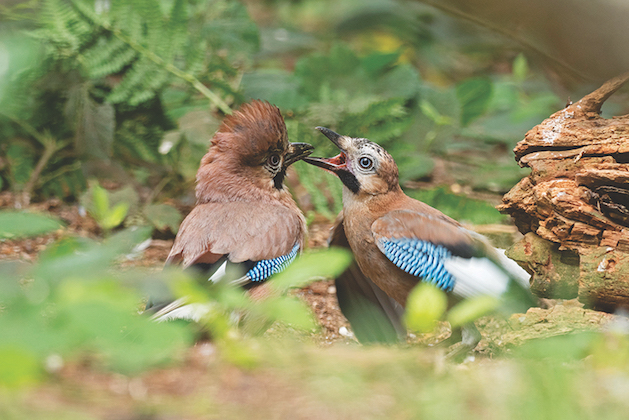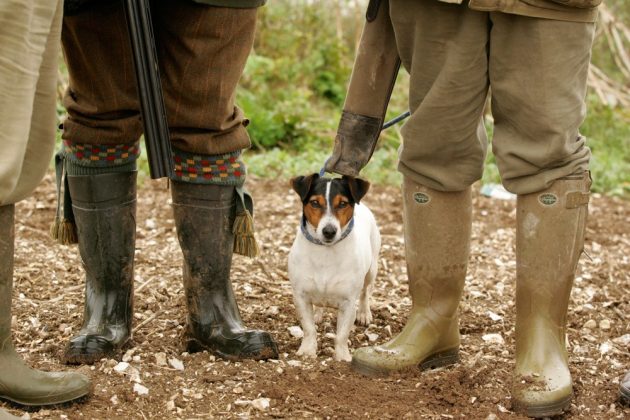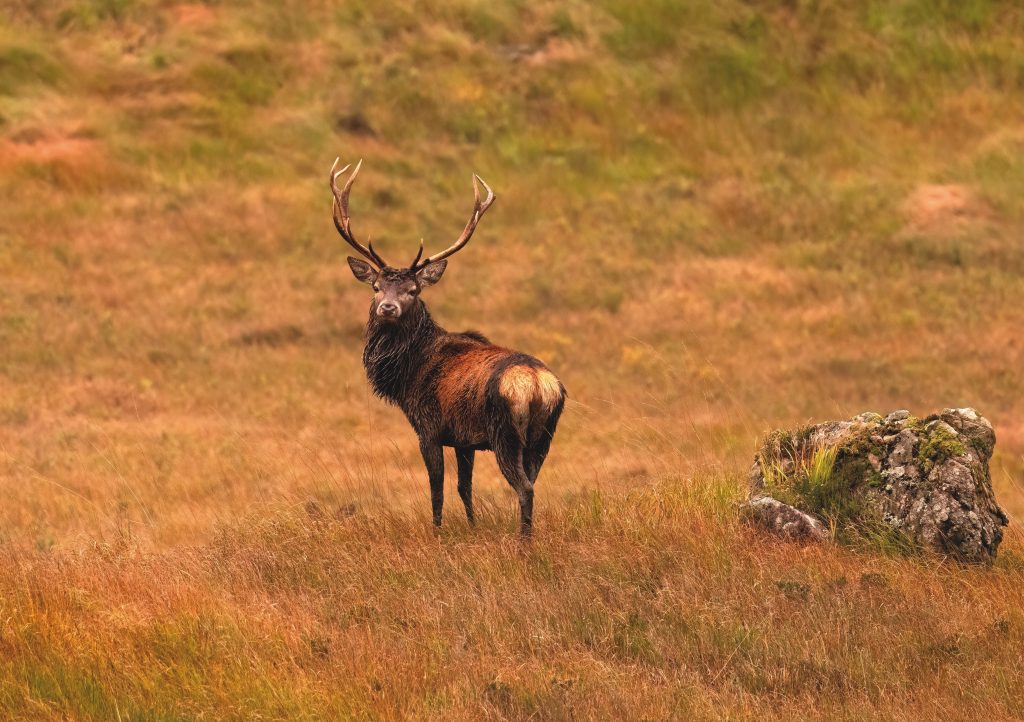Win CENS ProFlex DX5 earplugs worth £1,149 – enter here
All about the jay. Garrulus glandarius
 Flying eurasian jay with an acorn against a blue sky.
Flying eurasian jay with an acorn against a blue sky.
The Eurasian jay – the jay – is a common bird with a wide distribution within Europe and Asia. It can also be found as far south as parts of northern Africa and Iran, and across to the islands of Japan.
The jay – member of the crow family
About the size of a jackdaw, the jay is one of the most colourful members of the crow family, though it is a shy bird and few get the opportunity to inspect a live one closely. The first impression is of a light reddish-brown body, black wings with white flashes and a white rump patch above the tail. Closer up, the black moustachial markings below the beak become more apparent, as does the finely speckled black and white crest which can be raised and lowered as a means of communication. The bright blue and black wing feathers are probably their most striking feature and are prized by fly-tyers who use them for patterns such as the Invicta, Claret Jay and Blue Jay. They are also a traditional ingredient of that perennial favourite of salmon anglers, the Thunder and Lightning.
On the move
Jays are restless and constantly on the move. They prefer a woodland habitat and usually do not linger in the open where they are more vulnerable to predators. Unpaired birds form gatherings in early spring to choose the mates that they will probably stay with for the rest of their lives. These gatherings may only comprise four or five birds, but groups of more than 30 are occasionally seen. As part of the courtship ritual a male will start by offering food to a potential partner, often turning into a tug of war that seems to strengthen their bond. Once they have paired off, jays are seen less often until sightings increase during the autumn when they start to prepare for the coming winter.
The jay is a noisy bird, usually heard long before it is seen, and the Latin garrulus refers to its harsh, chattering call. In Gaelic it is called schreachag choillie, the ‘screamer of the woods’. The rasping screech of its alarm call carries a long way and many old-time keepers would deliberately preserve a pair or two in their woods to warn of poachers or predators in the area. It is also, like many other members of the crow family, a great mimic and can often sound like a totally different species. The songs of small birds and the alarm calls of magpies, blackbirds and tawny owls are all reproduced, and they have even been known to copy dripping taps, lawnmowers and human whistling.
Jays are known for their habit of using wood ants to help clean their feathers of parasites, lying on ant nests and rubbing against them with wings outspread. This encourages the defending insects to crawl all over their bodies and squirt them with the formic acid produced in their abdomens. At such times it does not appear that they eat the ants, though. Many people mistakenly assume that these ‘ant baths’ are the source of the glandarius in their scientific name. In fact, the word actually refers to acorns, so the name loosely translates as ‘noisy acorn eater’, reflecting one of the bird’s most favoured foods.
Jays are great hoarders, caching supplies of acorns and other nuts throughout the year and especially in autumn, when it has been estimated that just one bird can bury as many as 3,000 acorns in a single month as a supply against those to come.

The bird’s courtship ritual involves food and a tug of war
Woodland boost
Though they have highly developed memories for birds, many of these caches are never recovered and the jay is often credited with helping to regenerate woodland through these unintentional plantings. Indeed, some woodland owners consider this so important that they will not allow jays to be shot. It is widely believed that were it not for the jay dispersing and burying acorns, many European forests would not contain oak trees. Indeed, one Swedish study concluded that it would cost as much as £600,000 to employ people to replace the planting achieved by jays in a 2,700-hectare park.
Unusually among British birds, and particularly when you consider its bright plumage and distinctive habits, the jay seems to have very little folklore attached to it. There is no traditional collective noun, though the more modern ‘band’ or ‘scold’ are sometimes used, and in recent years attempts by a Canadian writer to introduce ‘a jabber’ met with only limited success. The expression ‘jay walker’, used to describe someone who crosses a road carelessly, seems to have its origins in the term ‘jay’ which was used in the late 18th century for a simple-minded person. Just how this name came to be associated with such an intelligent bird is difficult to understand.
All about the jay
- WORLD DISTRIBUTION: Widely distributed from Europe across to the eastern seaboard and south-east Asia
- UK DISTRIBUTION: Widespread across most of the UK but patchier in Scotland, and only very rarely seen in the north
- IUCN RED LIST STATUS: Least concern; stable
- HABITAT: A shy bird which prefers mixed woodland. Open spaces tend to be avoided. Occasionally encountered in urban areas and parks
- FOOD: Omnivorous; eats a wide range of invertebrates, nuts, seeds, berries, the eggs and young of other birds. Has also been known to eat small rodents and bats
- BREEDING: Monogamous; most pairs stay together for life
- NESTING: The deceptively untidy- looking but well-made nest is built from sticks in trees and shrubs, then lined with materials such as hair and roots. Very often only the female incubates the eggs, though sometimes the male will share responsibility. The young fledge after around 22 days
- CLUTCH SIZE: Four to six eggs
- INCUBATION TIME: 16 to 19 days
- LENGTH (AVERAGE): 35cm
- WINGSPAN (AVERAGE): 54cm to 58cm
- WEIGHT (AVERAGE): 150gm to 180gm
- LIFESPAN (AVERAGE): Normally three to five years. The oldest bird recorded in Britain was more than 16 years old
- FLIGHT SPEED: Around 20mph
- SHOOTING SEASON: May be killed or taken throughout the year under the terms and conditions of specific general licences
Related Articles
Get the latest news delivered direct to your door
Subscribe to Shooting Times & Country
Discover the ultimate companion for field sports enthusiasts with Shooting Times & Country Magazine, the UK’s leading weekly publication that has been at the forefront of shooting culture since 1882. Subscribers gain access to expert tips, comprehensive gear reviews, seasonal advice and a vibrant community of like-minded shooters.
Save on shop price when you subscribe with weekly issues featuring in-depth articles on gundog training, exclusive member offers and access to the digital back issue library. A Shooting Times & Country subscription is more than a magazine, don’t just read about the countryside; immerse yourself in its most authoritative and engaging publication.







